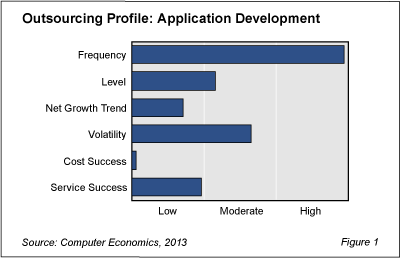Application development is the most frequently outsourced IT function. According to our annual study, two-thirds of all organizations outsourced some application development work last year. By most accounts, this practice has been rebounding from its recessionary low. In fact, our study indicates that application development outsourcing has now risen above pre-recession levels.
Application development outsourcing growth remains strong, but there are several challenges to overcome. First, although it is the most frequently outsourced function, our findings show that the customer experience has been less than spectacular: application development outsourcing ranks low in cost and service success in comparison to the outsourcing of other IT functions.
The outsourcing profile in Figure 1 from our report, Application Development Outsourcing Trends and Customer Experience, shows how outsourcing of the application development function compares with the outsourcing of 11 other IT functions in the parent study, IT Outsourcing Statistics.

In brief, our study makes the following findings:
-
Outsourcing frequency is extremely high, but level not deep. Application development outsourcing scores in the very high range in frequency, meaning that the number of organizations currently using these services is extremely high relative to the outsourcing of other functions. The outsourcing level, however, is moderate. When organizations outsource application development, they often outsource only a portion of the function.
-
Trend indicates growth may be slowing. The growth trend is a measure of the number of customers that plan to increase the amount of application development work given to outside service providers in the current budget cycle, minus the percentage that are decreasing the amount of work outsourced. In relative terms, growth in the amount of work organizations are outsourcing will be low. On the other hand, the volatility is moderate. The percentage of organizations changing the amount of work they outsource, regardless of whether the change is up or down, is in line with other outsourced IT functions. Some organizations are increasing outsourcing activity while others are reducing it.
- Cost and service experiences are poor. Finally, the profile shows the relative performance on our two measures of customer experience. IT organizations experience surprisingly low success in reducing costs when outsourcing the application development function. The service-success ratio is better, but not overwhelming. There are likely other motives behind the outsourcing of this function such as the need to augment internal IT services with specialized expertise, focus internal staff on new or proprietary development, increase flexibility, or simply access a wider IT talent pool.
In light of current trends, the full study is designed to help IT executives compare their application development outsourcing activity and experience with other IT organizations. The study uses three metrics to measure application development outsourcing: it determines how many organizations outsource application development (frequency), how much of the workload is typically outsourced (level), and the change in the amount of work being outsourced (trend). We also measure the cost experience and service experience of companies that outsource this function, and determine how outsourcing activity and experience vary by organization size and sector.
This Research Byte is a brief overview of our report on this subject, Application Development Outsourcing Trends and Customer Experience. The full report is available at no charge for Computer Economics clients, or it may be purchased by non-clients directly from our website (click for pricing).

